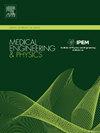A finite element model to simulate intraoperative fractures in cementless hip stem designs
IF 1.7
4区 医学
Q3 ENGINEERING, BIOMEDICAL
引用次数: 0
Abstract
Intraoperative femur fractures are a complication of hip arthroplasty, strongly related to the cementless stem design; this kind of fracture is not always recognised during surgery, and revision surgery may be necessary. The present study aimed to simulate intraoperative crack propagation during stem implantation using subject-specific quasi-static finite element models. Eleven subject-specific finite element femur models were built starting from CT data, and the implant pose and size of a non-commercial cementless stem were identified. The model boundary conditions were set with a compressive load from 1000 N to 10 000 N, to simulate the surgeon's hammering, and element deactivation was used to model the crack propagation. Two damage quantifiers were analysed to identify a threshold value that would allow us to assess if a fracture occurred. A methodology to assess the primary stability of the stem during insertion was also proposed, based on a push-out test. Crack propagation up to the surface was obtained in six patients; in two cases there was no crack generation, while in three patients the crack did not reach the external surface. This study demonstrates the possibility to simulate the propagation of the fracture intraoperatively during hip replacement surgery and generate quantitative information about the bone damage using a virtual cohort of simulated patients with anatomical and physiological variability.
模拟无骨水泥髋关节设计术中骨折的有限元模型
术中股骨骨折是髋关节置换术的并发症,与无骨水泥的髋关节设计密切相关;这种骨折在手术中并不总是被识别出来,可能需要进行翻修手术。本研究旨在利用特定对象的准静态有限元模型模拟干植入过程中的术中裂纹扩展。从CT数据开始,建立了11个受试者特定的有限元股骨模型,并确定了非商业无骨水泥柄的植入物姿势和尺寸。模型边界条件设置为1000 ~ 10 000 N的压缩载荷,模拟外科医生的锤击过程,单元失活模拟裂纹扩展。我们分析了两个损伤量化指标,以确定一个阈值,以便我们评估是否发生了骨折。还提出了一种基于推出测试的方法来评估插入过程中杆的主要稳定性。在6例患者中,裂纹扩展至表面;其中2例未产生裂纹,3例裂纹未到达外表面。本研究证明了在髋关节置换术中模拟骨折传播的可能性,并使用具有解剖和生理变异的模拟患者的虚拟队列生成有关骨损伤的定量信息。
本文章由计算机程序翻译,如有差异,请以英文原文为准。
求助全文
约1分钟内获得全文
求助全文
来源期刊

Medical Engineering & Physics
工程技术-工程:生物医学
CiteScore
4.30
自引率
4.50%
发文量
172
审稿时长
3.0 months
期刊介绍:
Medical Engineering & Physics provides a forum for the publication of the latest developments in biomedical engineering, and reflects the essential multidisciplinary nature of the subject. The journal publishes in-depth critical reviews, scientific papers and technical notes. Our focus encompasses the application of the basic principles of physics and engineering to the development of medical devices and technology, with the ultimate aim of producing improvements in the quality of health care.Topics covered include biomechanics, biomaterials, mechanobiology, rehabilitation engineering, biomedical signal processing and medical device development. Medical Engineering & Physics aims to keep both engineers and clinicians abreast of the latest applications of technology to health care.
 求助内容:
求助内容: 应助结果提醒方式:
应助结果提醒方式:


